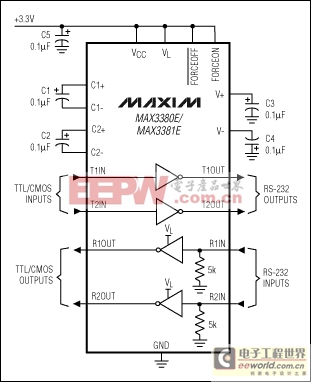模擬集成電路的低電壓系統(tǒng)-Analog ICs for Lo
Table 4. Comparison of 232E and 562 Interface Standards
| Parameter | EIA-232E | EIA-562 |
| Mode of operation | Single ended | Single ended |
| Allowed number of transmitters and receivers per data line | 1 Tx, 1 Rx | 1 Tx, 1 Rx |
| Maximum cable length | C 2500pF | C 2500pF for data rates 20kb/s,C 1000pF for data rates > 20kb/s |
| Maximum data rate (kb/s) | 20 | 64 |
| Driver output voltage, loaded (V) | minimum | |
| ±5 | ±3.7 | |
| maximum | ||
| ±15 | ±13.2 | |
| Maximum driver short-circuit current (mA) | 500 | 60 |
| Transmitter load impedance (kΩ) | 3 to 7 | 3 to 7 |
| Instantaneous slew rate (V/μs) | 30 | 30 |
| Receiver input threshold (sensitivity) (V) | ±3 | ±3 |
| Receiver input resistance (kΩ) | 3 to 7 | 3 to 7 |
| Receiver input range (V) | ±25 | ±25 |
Most modern Maxim RS-232 devices with low-voltage supplies employ voltage-increasing charge-pump converters, sometimes requiring external capacitors. Many Maxim RS-232 devices feature automatic shutdown, and draw only 1μA of current until "awakened" by the RS-232 communication signal. The MAX3381E (Figure 13) operates from as low as 2.35V with a guaranteed data rate of 250kbps, and features ±15kV of built-in ESD protection. Its two receivers remain active during the 1μA shutdown mode, enabling the chip to monitor external devices while consuming small amounts of power. The MAX218 (not shown) operates down to +1.8V and uses a switch-mode power converter, which requires an external inductor, a diode, and a few capacitors.

Figure 13. This low-voltage interface IC includes a charge pump converter that generates the voltages required for RS-232 communications.
DIY機械鍵盤相關(guān)社區(qū):機械鍵盤DIY









評論